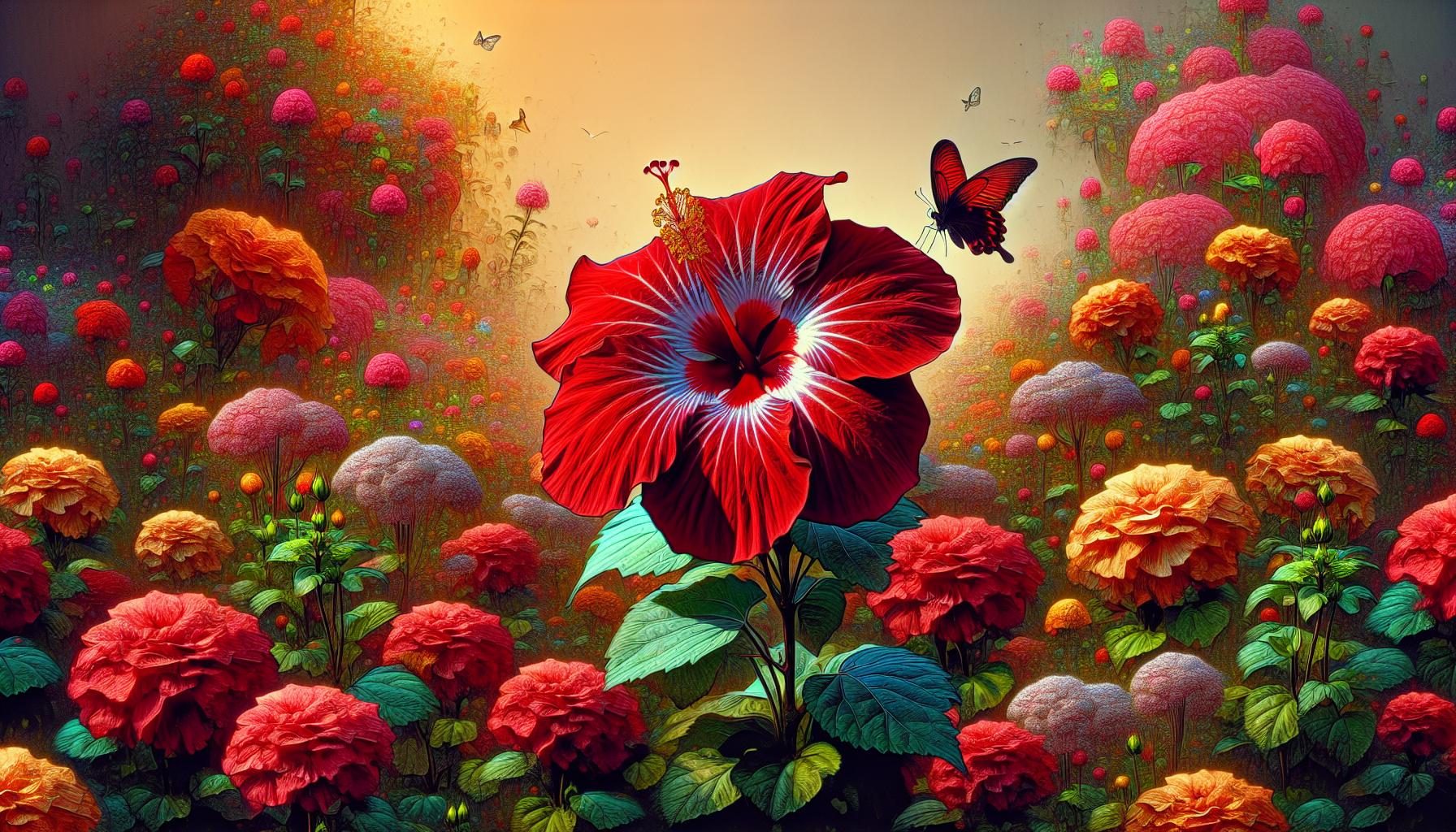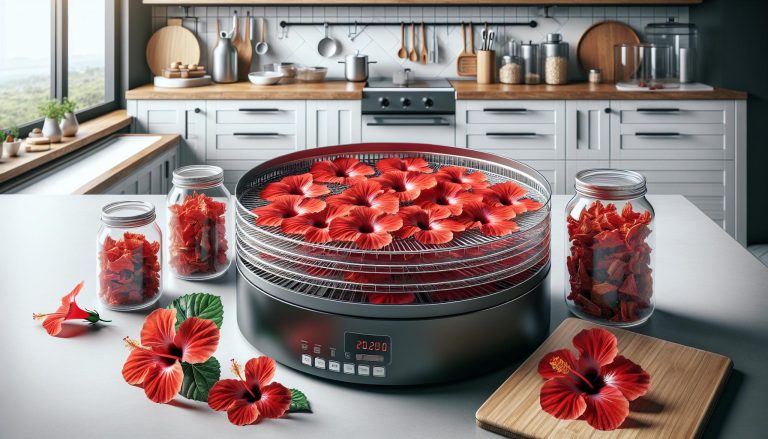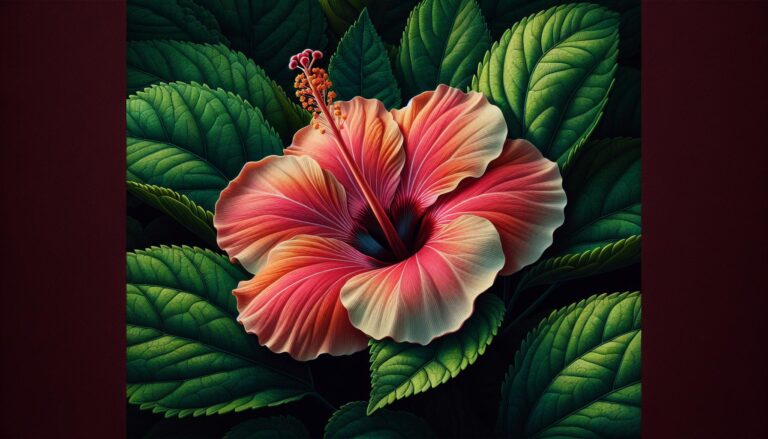Transform Your Garden: Grow Vibrant Red Hardy Hibiscus
As garden enthusiasts, we’re always on the lookout for plants that not only add beauty to our landscapes but also thrive with minimal fuss. Enter the Luna Red Hardy Hibiscus, a true gem for both pond settings and garden landscapes. Known for its stunning large red blooms, this plant is a late summer showstopper, offering a burst of color when many other plants begin to fade.
What sets the Luna Red Hardy Hibiscus apart is its remarkable resilience. Thriving in full sun and capable of withstanding winter’s chill, this plant is a testament to both beauty and strength. It’s not just its visual appeal that captivates us; its adaptability to various planting environments – from pots in ponds to traditional garden settings – makes it a versatile choice for gardeners.
Join us as we dive into the world of the Luna Red Hardy Hibiscus, exploring the secrets behind its vibrant blooms and robust nature. Whether you’re looking to add a pop of color to your pond or seeking a hardy addition to your garden, this plant is sure to impress.
Key Takeaways
- Versatile and Low-Maintenance: The Luna Red Hardy Hibiscus, along with its varieties like ‘Fireball’ and ‘Cranberry Crush’, thrives in full sun and tolerates winter well, making it an excellent choice for gardeners looking for low-maintenance, yet strikingly beautiful additions to their landscapes.
- Attracts Pollinators and Wildlife: Beyond their beauty, these plants play a crucial role in attracting pollinators such as bees, butterflies, and hummingbirds to gardens, thereby supporting local ecosystems and promoting biodiversity.
- Adaptable Planting Options: Red Hardy Hibiscus is remarkably adaptable, thriving in various environments, from pond settings to traditional garden beds, offering gardeners flexibility in design and landscaping choices.
- Care and Maintenance Tips: Successful cultivation involves selecting locations with full sun, ensuring proper soil conditions, and following specific watering, fertilization, and pruning practices to encourage vibrant blooms and robust health.
- Environmental and Aesthetic Benefits: These plants contribute to soil conservation and enhance garden biodiversity, all while offering a stunning visual display with their large, vivid red flowers that bloom from mid-summer to early fall.
- Resilience Against Pests and Diseases: While Red Hardy Hibiscus is generally resilient, gardeners should employ organic pest management strategies and ensure good air circulation to prevent common diseases, maintaining the plant’s health and vibrancy.
Overview of Red Hardy Hibiscus
Characteristics and Varieties
The Red Hardy Hibiscus, known for its strikingly large, vibrant red blooms, stands as a testament to the beauty and diversity nature offers. Among its varieties, the Luna Red Hardy Hibiscus has garnered attention for its exceptional resilience and ability to produce stunning flowers from mid-summer to early fall. These plants typically grow to a height and width of 4 to 5 feet, creating a bold statement in any garden.
Varieties of Red Hardy Hibiscus differ not only in size but also in the shade of red and bloom shape, offering gardeners a range of options to suit their landscape design. For example, the ‘Fireball’ cultivar presents deeper red blooms and a more bushy habit, while ‘Cranberry Crush’ offers a compact form with dark, cranberry-colored flowers. Each variety possesses its own unique charm, contributing to the overall appeal of these hardy perennials.
Importance in Gardens
Incorporating Red Hardy Hibiscus into gardens brings forth a multitude of benefits. Firstly, their robust nature and adaptability to full sun conditions make them invaluable components of low-maintenance landscapes. Thanks to their resistance to winter’s chill, these plants return year after year, providing a perennial source of vivid color and visual interest.
Moreover, Red Hardy Hibiscus serves as an important attractant for pollinators such as bees and hummingbirds, which play a crucial role in the health of our gardens and wider ecosystems. Their large, conspicuous flowers not only captivate human admirers but also act as an essential food source for these pollinators.
Lastly, their versatility is unparalleled. Whether planted along pond edges, used as striking focal points in flower beds, or incorporated into mixed borders, Red Hardy Hibiscus enhances aesthetic appeal and brings life to various garden settings. This adaptability, coupled with their breathtaking blooms, underscores the importance of Red Hardy Hibiscus in enhancing biodiversity and beauty in gardens across diverse climates.
How to Plant and Care for Red Hardy Hibiscus

Choosing the Right Location
Finding the perfect spot for a Red Hardy Hibiscus is paramount for its growth and bloom. These plants thrive in full sun, needing approximately six hours of direct sunlight daily. A location that receives mostly sunny to full sun exposure aligns perfectly with their needs, ensuring they produce their vibrant, signature blooms. Additionally, areas with ample morning sunlight but some afternoon shade can also be suitable, especially in hotter climates, to prevent leaf scorch.
Soil Requirements and Preparation
The ideal soil for Red Hardy Hibiscus plants drains well yet retains enough moisture to keep the roots hydrated. Before planting, it’s essential to ensure the soil is not too heavy or clay-like. If necessary, improve drainage by incorporating organic matter, such as compost or peat moss, into the planting area. The pH of the soil should ideally be neutral to slightly acidic. Testing the soil beforehand can help determine if any adjustments in pH are needed by adding lime (to increase pH) or sulfur (to decrease pH).
Planting Tips
When planting a Red Hardy Hibiscus, dig a hole that is one and a half times wider than the plant’s container but no deeper. This allows the root system to spread without forcing it too deep, which can stress the plant. Position the hibiscus in the hole so that the top of the root ball is level with the ground surface. After positioning, backfill with the excavated soil, gently firming it down without compacting too much, which could hinder root growth. Initial thorough watering after planting is crucial to settle the soil around the roots and eliminate air pockets.
Watering and Fertilization
Maintain a consistent watering schedule for the Red Hardy Hibiscus, ensuring the plant receives enough moisture without becoming waterlogged. During the first growing season, watering helps establish a deep, extensive root system. Mulching around the base with a 2-inch layer of organic matter preserves soil moisture and reduces weed competition. For fertilization, a phosphorus-high fertilizer encourages blooming. Apply as directed on the product label, typically in early spring as growth resumes and again just before bloom season.
Pruning and Maintenance
Pruning in early spring, before new growth starts, promotes a bushier growth habit and encourages more blooms. Remove any dead or diseased branches to maintain plant health. Additionally, deadheading spent flowers throughout the blooming season boosts the plant’s energy for more blooms. Monitor for pests like aphids and spider mites, addressing infestations promptly to prevent damage. Over winter, in cooler zones, protect outdoor plants with mulch or bring container plants indoors to prevent frost damage.
By following these tips, gardeners can ensure their Red Hardy Hibiscus plants remain healthy, vibrant, and blooming beautifully, enhancing their garden’s biodiversity and aesthetic appeal.
Red Hardy Hibiscus Through the Seasons

Spring Care
As the weather warms in spring, our focus turns to prepping Red Hardy Hibiscus plants for the upcoming bloom season. We start by trimming any dead foliage from the previous year, a process that encourages fresh, vigorous growth. It’s essential to wait until the threat of frost has passed before pruning, as early sprouts are sensitive to cold. We enrich the soil with a balanced, slow-release fertilizer to provide essential nutrients for growth. Additionally, we ensure the planting site offers ample sunlight and well-draining soil, setting the stage for a healthy growing season. Regular watering begins in spring, keeping the soil consistently moist but not waterlogged, as Red Hardy Hibiscus thrives in moist conditions.
Summer Bloom
By summer, Red Hardy Hibiscus plants become the showstoppers of the garden, flaunting their large, radiant red blooms that can measure up to 8 inches across. These flowers typically start appearing in mid-summer and continue unabated until the first frost of fall. During this peak blooming period, we maintain a regular watering schedule to prevent stress on the plants, which can result in fewer blooms. Mulching around the base of the plants helps retain soil moisture and keeps roots cool. Our plants benefit from a mid-season application of fertilizer to support sustained flowering. We also keep an eye out for pests and diseases, though Red Hardy Hibiscus’s disease resistance means issues are few and far between. The vibrant flowers not only enhance the garden’s beauty but also attract pollinators, adding to the biodiversity of our space.
Fall and Winter Care
As the blooming season wanes and fall approaches, we gradually reduce watering and let the plants harden off in preparation for winter. In regions where Red Hardy Hibiscus is perennial, we might add a layer of mulch for insulation after the first hard freeze to protect the roots. The stems of Red Hardy Hibiscus die back to the ground in colder climates, so we cut them to a few inches above the soil level once they’ve withered. Leaving the spent stems in place until late winter can provide some cold protection. We do not prune back live wood in fall, as the plants need to store energy for the next growing season. Instead, spring reveals the perfect time for such tasks, right before new growth starts. For gardeners in zones where Red Hardy Hibiscus is treated as an annual, plants can be removed after frost claims them, or if preferred, potted specimens can be overwintered indoors in a cool, dry place to be replanted the following year.
Through attentive care across the seasons, our Red Hardy Hibiscus plants continue to thrive year over year, bringing their unforgettable blooms to our gardens from summer to fall.
Attracting Wildlife with Red Hardy Hibiscus

Birds and Pollinators
Our vibrant Red Hardy Hibiscus varieties including Luna Red, ‘Fireball’, and ‘Cranberry Crush’, not only add spectacular color to the garden but also serve as a magnet for various wildlife, enhancing biodiversity. These varieties, known for their large, conspicuous red blooms, are highly attractive to a range of pollinators such as bees, butterflies, and hummingbirds. The nectar-rich flowers provide essential sustenance for these creatures, supporting their daily energy needs and contributing to the pollination of plants. Birds, particularly hummingbirds, are drawn to the bright red flowers of the Red Hardy Hibiscus. Their visits not only aid in pollination but also offer gardeners the pleasure of observing wildlife up close.
Planting Red Hardy Hibiscus in our gardens offers an effortless way to support local ecosystems while enjoying the dual benefits of stunning floral displays and watching the flurry of activity it brings. By choosing these low-maintenance, versatile plants, we invite a symphony of birds and pollinators that play a crucial role in the health of our gardens.
Pest Management
While Red Hardy Hibiscus is a beacon for beneficial wildlife, it’s also important to mention its resilience against pests. These hardy plants have developed a tolerance to many common garden pests, minimizing the need for chemical interventions. In our experience, maintaining healthy Red Hardy Hibiscus through proper fertilization, watering, and sunlight exposure significantly reduces pest infestations. However, should pests become a concern, we recommend employing organic pest management strategies.
For instance, introducing natural predators like ladybugs and lacewings can help control aphid populations. Similarly, applying neem oil, a natural pesticide, can deter pests without harming the plant or beneficial insects. It’s vital to monitor your Red Hardy Hibicus plants regularly for signs of pests and to address any issues promptly with environmentally friendly solutions.
By incorporating Red Hardy Hibiscus into our gardens, we not only enhance the aesthetic appeal with their mesmerizing red blooms but also contribute to a vibrant, healthy ecosystem. Our mindful approach to attracting wildlife and managing pests ensures our gardens remain a sanctuary for us and the natural world around us.
Common Challenges and Solutions

Disease Prevention
In our experience, Red Hardy Hibiscus plants are remarkably resilient, but they’re not immune to diseases. One common issue is fungal diseases, such as rust or leaf spot, which thrive in damp conditions. To prevent this, we recommend ensuring good air circulation around each plant. Spacing them 2 to 3 feet apart, as mentioned earlier, is crucial. Additionally, applying a mulch layer helps keep soil moisture consistent, reducing water splash and the spread of fungal spores. If you notice any signs of fungal disease, it’s essential to act quickly. Removing affected leaves and applying a fungicide can often keep the problem from spreading. Remember, prevention is key, so maintaining a healthy environment for your Red Hardy Hibiscus will significantly reduce the risk of disease.
Handling Pests
Pests can sometimes pose a challenge to Red Hardy Hibiscus plants. Japanese beetles and aphids are among the common culprits. These pests not only damage the foliage but can also stress the plant, making it more susceptible to diseases. Our recommended approach to pest control emphasizes organic methods. Introducing beneficial insects like ladybugs helps control aphid populations naturally. For Japanese beetles, handpicking them early in the morning when they are less active can effectively reduce their numbers. In addition, applying neem oil or insecticidal soap can offer a safe, effective way to manage these pests without harming beneficial insects or the environment. Regular monitoring of your plants and taking prompt action when pests are spotted will help ensure that your Red Hardy Hibiscus plants remain healthy and vibrant.
Benefits of Growing Red Hardy Hibiscus

Environmental Impact
Growing Red Hardy Hibiscus in our gardens contributes significantly to the local ecosystem. These plants serve as an essential food source for various pollinators, including hummingbirds, butterflies, and bees. By attracting these beneficial insects, we aid in the pollination of nearby plants, enhancing our garden’s biodiversity and productivity. Furthermore, Red Hardy Hibiscus plants can help in soil conservation. Their root systems are adept at stabilizing soil, preventing erosion, and improving soil health by fostering a habitat rich in microorganisms. This, in turn, supports a more sustainable and eco-friendly garden environment. By choosing to cultivate Red Hardy Hibiscus, we’re not only beautifying our spaces but also promoting a healthier planet.
Aesthetic Appeal
The vibrant, show-stopping blooms of the Red Hardy Hibiscus are undeniably its most striking feature. Varieties such as ‘Luna Red,’ ‘Fireball,’ and ‘Cranberry Crush’ produce large, eye-catching flowers that can make any garden space come alive with color. These perennials are particularly valued for their late summer blooming, a time when many other plants start to fade, providing our gardens with a much-needed burst of color late into the season. Moreover, their broad, dark green leaves offer a lush backdrop that further accentuates their bright red blooms, enhancing the overall aesthetic appeal of our outdoor spaces. The bold, dramatic presence of the Red Hardy Hibiscus makes it a focal point in any landscape design, from cottage gardens to modern minimalist settings. By incorporating these plants into our gardens, we create breathtaking vistas that uplift our spirits and transform our outdoor areas into vibrant sanctuaries of beauty.
Real-Life Success Stories
Garden Transformations
Our journey with Red Hardy Hibiscus has led to numerous garden transformations, where once lackluster spaces become vibrant showcases of color and life. Take, for instance, a suburban garden in Zone 5 that embraced the ‘Luna Red’ variety. Initially, the garden struggled to find its identity amidst a sea of common perennials. However, planting a series of Red Hardy Hibiscus created a dramatic focal point, their large, crimson blossoms providing visual depth and contrast that was previously missing.
Another transformation story comes from a rooftop garden in a bustling city, where space and heavy winds challenge every plant’s survival. By incorporating ‘Cranberry Crush’ into container gardens, not only did the flora thrive, offering a lush, green retreat in an urban setting, but it also added a layer of privacy and sound insulation, turning the space into a serene sanctuary. The reliability and hardiness of these plants ensured they could withstand the conditions, proving that beauty and resilience can coexist.
Wildlife Encounters
Beyond aesthetic enhancements, Red Hardy Hibiscus plants have played pivotal roles in nurturing local wildlife, creating a ripple effect of biodiversity. In rural gardens, the introduction of ‘Fireball’ varieties has been credited with a noticeable increase in bee and butterfly populations. These pollinators, once sparse due to habitat loss and other environmental pressures, now flourish as the ample nectar and pollen provided by the hibiscus blooms offer essential resources for their survival. Gardeners have reported watching with delight as their gardens buzz and flutter with activity throughout the blooming season.
Bird enthusiasts have shared equally heartwarming stories, with hummingbirds frequently visiting the vibrant red flowers. A particularly touching account involved a family who, after planting a row of Luna Red Hibiscus along their property, noticed an increase in hummingbird sightings, including nesting in nearby trees. This not only provided the family with endless observation opportunities but also contributed to the local ecosystem’s health by supporting species that pollinate many types of plants.
Our experiences and those of our fellow gardeners underscore the importance and impact of choosing plants like the Red Hardy Hibiscus. These real-life success stories highlight not just the transformation of spaces but also the positive effects on local wildlife, promoting a healthier, more vibrant, and interconnected ecosystem.
Conclusion
We’ve seen firsthand how Red Hardy Hibiscus plants can breathe life into any garden, turning the mundane into the magnificent. Their vibrant blooms and environmental benefits make them a top choice for gardeners looking to make a positive impact. From ‘Luna Red’ to ‘Cranberry Crush,’ these varieties offer a palette of options that cater to diverse tastes and landscapes. As we’ve explored, their role extends beyond beautification, playing a crucial part in supporting our local wildlife and ecosystems. Embracing Red Hardy Hibiscus in our gardens means not only enjoying their stunning display but also contributing to a healthier, more vibrant world. Let’s continue to spread the word and inspire more green spaces filled with these extraordinary blooms.






